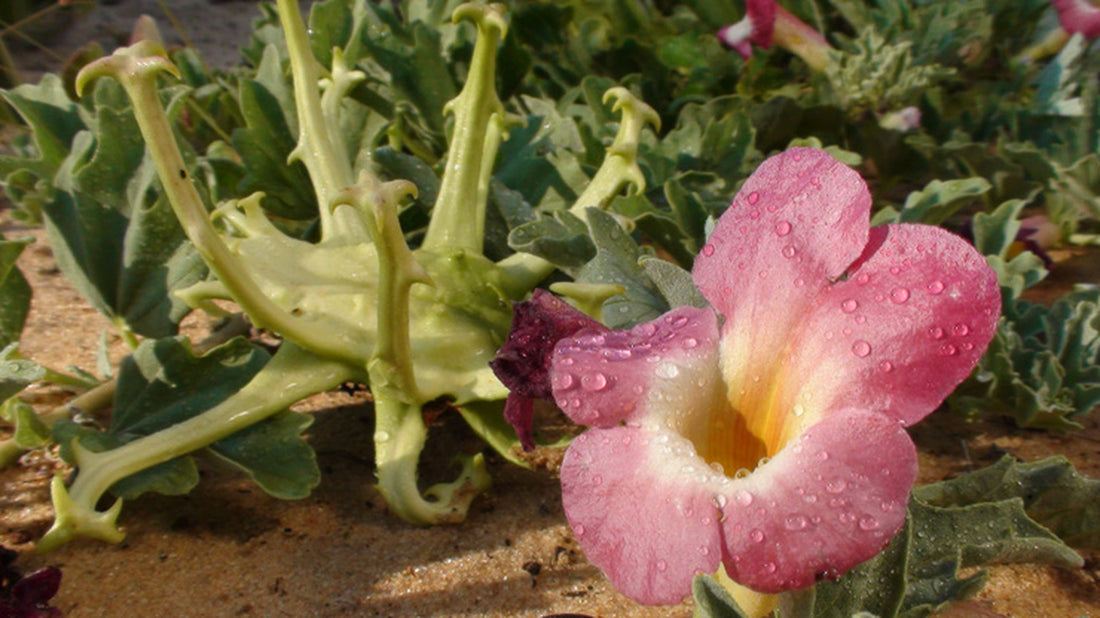
April: Botswana Devil's Claw
This month we’re exploring Botswana’s national flower, Devil’s Claw. Often referred to as the Kalahari Devil’s Claw, as it grows in the Kalahari desert, this plant is indigenous to the most barren corners of the country and encapsulates Botswana’s history as a strong, stable nation according to their agencies.
Indigenous and Medicinal Uses
Historically, the native Khoisan people harvested Devil’s Claw for its various medicinal purposes in Africa. The tube roots of Devil’s Claw are traditionally cut open and dried to be made into teas or packaged to sell. For centuries, the plant has been used as an herbal medicine to treat a span of illnesses, mainly as an anti-inflammatory. In the late 1800s it was introduced to western markets for its herbal remedies.
|
||||||||||||||
Taxonomy + Ecology
Devil’s Claw or Harpagophytum procumbens is in the sesame seed family and is also referred to as grapple plant and wood spider. It gets its name from its strange hooked fruit and roots. Harpagophytum, is derived from the Greek words harpago meaning "hook" and phyton meaning "plant”.
Harpagophytum procumbens inhabits deep, sandy soils and grows in areas with low annual rainfall. It’s a tuberous plant, and its above-ground stems emerge after the first rains and die back during droughts or frosts. The stems grow from a primary tuber and several secondary tubers at the end of fleshy roots.
|
|||||||||||||||
Devil’s Claw and Horse Racing
I never thought I’d be writing to you about this, but interestingly enough, Devil’s Claw has become quite scandalous in the world of horse racing. Since it’s a potent anti-inflammatory, many horse owners use it to help their horses support healthy tissue, muscles, and joints. On top of that, it may help with muscular recovery after intense exercise, which is where horse racing comes in. I myself know very little about the world of horse racing but found that the FEI (Federation for Equestrian Sports, or in french, Fédération Équestre Internationale) publishes a list of substances that are not allowed to be used during competitions. Devil’s Claw made the cut! Specifically the active ingredient – Harpagoside. It was added to the Equine Prohibited Substances List as a Controlled Medication in 2016. From what I found, Harpogaside acts like aspirin, which is a firm no in the equine world. In more commercial selling, Devil’s Claw has had some spotlight as well as a homeopathic supplement and even as a fun houseplant!
Fun Facts!
|
|
||||||||||||
|
|
||||||||||||||
Devil’s Claw growing in desert soil has much to teach us. I’m very interested in its history in Africa, but didn’t find as much documentation as I was hoping. I found it a bit striking that I could find more about Devil’s Claw in horse racing than I could on its indigenous history. As always, if you decide to purchase or grow this plant, be wary of where it’s coming from and its harvesting!
[1] https://www.theguardian.com/us-news/2015/sep/10/new-york-attorney-general-devils-claw
[2] https://www.horseandpethealth.com/is-devils-claw-banned-by-the-fei/#:~:text=Devil's%20Claw%20and%20the%20FEI&text='Banned%20Substances'are%20substances%20that,competition%20horse%20at%20any%20time
[3] https://www.edimentals.com/blog/?p=25888
[4] https://www.herbalreality.com/herb/devils-claw/
[5] https://synkroniciti.com/a-dream-of-willow-tom-hares-seed-walk/
[6] https://www.ncbi.nlm.nih.gov/pmc/articles/PMC9182060/
[7] https://pubmed.ncbi.nlm.nih.gov/9140234/



